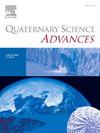Radiocarbon age anomalies, potential carbon sources analysis and correction of terrestrial gastropods in a loess sequence from Kunlun Mountains since 3.6 ka
IF 2.2
Q2 GEOGRAPHY, PHYSICAL
引用次数: 0
Abstract
Terrestrial mollusks serve as potential radiocarbon materials for dating loess deposits in the late Quaternary. However, the reliability of gastropod shell 14C ages is complicated by two issues: open-system behavior and the limestone problem. Due to lack of assessment on the preservation status of shell fossils and factors affecting old carbon, correction for age anomalies remains an unresolved question. This study investigated two gastropod shells, Cathaica rossimontana and Succinea sp., discovered from a loess section rich in charcoal in the North Kunlun Mountains of Central Asia. By analyzing local climate condition, leaching degree, and mineral composition, we revealed that the open systems have a negligible influence on shell fossils. The values of age anomalies of Cathaica rossimontana and Succinea sp. are respectively 1788 ± 240 years and 492 ± 100 years. Furthermore, we obtained the temporal variation patterns of different carbon sources in shell fossils through a mass balance model analysis. The results indicate that the proportion of carbonate sources ranges from 17.5% to 26.8% in Cathaica rossimontana, while it ranges from 6.0% to 7.8% in Succinea sp., which may result from their size and calcium demand. Succinea sp. is recommended for stratigraphic dating for its minor age anomalies. Our study further demonstrates that snails of the same species absorb a highly consistent proportion of limestone under stable environment. This provides a theoretical basis for correcting age anomalies in fossil shells. The corrected ages of Cathaica rossimontana, based on living specimens, are consistent with reliable charcoal ages. Our findings offer a potential approach to correct the old carbon in snail fossils and facilitate the reliable dating for loess deposits in Central Asia.
昆仑山3.6 ka以来黄土层序陆生腹足类放射性碳年龄异常、潜在碳源分析及校正
陆生软体动物是测定晚第四纪黄土沉积年代的潜在放射性碳材料。然而,腹足类贝壳14C年龄的可靠性由于两个问题而变得复杂:开放系统行为和石灰岩问题。由于缺乏对贝壳化石保存状况和古碳影响因素的评估,对年龄异常的校正仍然是一个未解决的问题。本文研究了在中亚北昆仑山富炭黄土中发现的Cathaica rossimontana和Succinea sp.两种腹足类贝壳。通过对当地气候条件、淋溶程度和矿物组成的分析,我们发现开放体系对贝壳化石的影响可以忽略不计。花楸和琥珀的年龄异常值分别为1788±240年和492±100年。此外,我们还通过质量平衡模型分析得到了贝壳化石中不同碳源的时间变化规律。结果表明,赤山Cathaica rossimontana的碳酸盐源比例为17.5% ~ 26.8%,琥珀属sucinea sp.的碳酸盐源比例为6.0% ~ 7.8%,这可能与它们的大小和钙需求有关。琥珀属(Succinea sp.)年龄异常较小,推荐用于地层定年。我们的研究进一步表明,在稳定的环境下,同一物种的蜗牛吸收石灰石的比例是高度一致的。这为修正化石壳的年龄异常提供了理论依据。基于活标本的红牡丹校正年龄与可靠的木炭年龄是一致的。我们的发现为纠正蜗牛化石中的旧碳和促进中亚黄土沉积物的可靠测年提供了一种潜在的方法。
本文章由计算机程序翻译,如有差异,请以英文原文为准。
求助全文
约1分钟内获得全文
求助全文
来源期刊

Quaternary Science Advances
Earth and Planetary Sciences-Earth-Surface Processes
CiteScore
4.00
自引率
13.30%
发文量
16
审稿时长
61 days
 求助内容:
求助内容: 应助结果提醒方式:
应助结果提醒方式:


